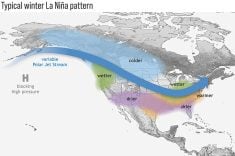The loss of PMU ranches has been like a kick to the stomach for rural communities.
There used to be more than 400 pregnant mare’s urine farms across the Canadian Prairies and in North Dakota. During the past two years, that number has been whittled down to 73.
The effects have been obvious at Deloraine, a community in southwestern Manitoba that used to have 20 PMU producers in the area but now is down to only two.
“They’re not spending as much money at the restaurants or the local stores,” said Jack Edwards, deputy reeve for the rural municipality surrounding Deloraine. “It all kind of goes down the food chain.
Read Also

Canadian Food Inspection Agency extends chronic wasting disease control program consultation deadline
Date extended for consultation period of changes to CWD program
“Every one of them bought vehicles, especially the bigger dual trucks and that for pulling trailers. I know the garages are sure not near as busy as they used to be with those fellas in the business.”
Descriptions of the impact are no longer only anecdotal. Equine Canada has done a study that attaches a price tag to the cutbacks in the PMU industry.
In 2003, $21 million was spent by PMU operators for the care of their horses, which included feed and veterinary costs, said Don Adams, Equine Canada’s executive director. This year, that spending will be down to $4.3 million among the PMU farms that remain.
Meanwhile, Equine Canada has estimated that $60 million was not spent on property improvements as a consequence of the cuts. The improvements to property would have included construction of new barns, improvements to existing buildings and machinery purchases.
“Obviously, when you go from 36,000 mares down to 7,000 mares, everybody’s affected,” said Adams. “Vets are affected. The feed stores are affected. It has an effect on the whole industry in the area.”
The full impact has not yet been felt, however. There are still producers receiving transitional money from the PMU industry to help them adjust. That money will end next year.
“PMU operators tended to be clustered to facilitate trucking (of the pregnant mare’s urine),” said Les Burwash, Alberta Agriculture’s manager of horse programs. “Those communities are going to really see the impact starting in 2006.”
Earlier this year, the remaining PMU producers in Alberta were told their contracts would not be renewed.
“We won’t have all those producers with the cash flows,” Burwash said. “We’re going to see the businesses in those communities suffer big time. Yes, those people are still going to be there, and yes they’re still going to be in the horse business, but instead of having 150 head of mares they’re going to have 20.
“It was unfortunate. I think it was bad for the horse industry as a whole that we’re losing a valuable agricultural enterprise and I don’t expect that we’ll see it come back either.”
The cuts to the PMU industry were partly the result of medical research that recommended smaller doses over short periods of time for women prescribed the hormone replacement derived from pregnant mare’s urine.














